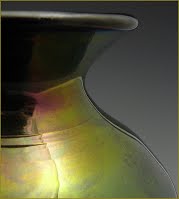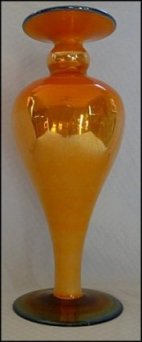Lustre Glazes
I hope the information and photos I am providing here will help enhance an appreciation for Imperial’s Lead Lustre art glass.
I spent a week or so closely examining the Lead Lustre vases in my possession. The results of this effort have left me with a greater appreciation for the creative thought and technical skill that went into the making of this line.
 This is in some respects an initial effort to "peel the onion" back another layer regarding Lead Lustre; primarily to explore the lustres used and the effects of lustres on different colors of glass, thickness of lustre application on appearance, etc. I do not believe this has been done before. As a fledgling effort, I am sure I have/will make many mistakes. I'm equally sure however that over time, with the help of others and perhaps the discovery of factory records, this effort will be improved.
This is in some respects an initial effort to "peel the onion" back another layer regarding Lead Lustre; primarily to explore the lustres used and the effects of lustres on different colors of glass, thickness of lustre application on appearance, etc. I do not believe this has been done before. As a fledgling effort, I am sure I have/will make many mistakes. I'm equally sure however that over time, with the help of others and perhaps the discovery of factory records, this effort will be improved.
Here then are definitions and my observations, including a detailed description of each of the 23 documented Lead Lustre decors:
- Bone white glass, lead glass, was used as the base glass in 19 of the 23 decors and in the decoration of three of the remaining four decors, i.e. opal in marbleizing or opal festoons. Hence the "lead" in Lead Lustre. The only decor without white glass is Decor #10.
- Both lustres and/or iridescent finishes can be found somewhere on all 23 decors - hence the "lustre" in Lead Lustre.
- Lustre - a uniform, shiny finish on the surface of transparent or opaque glass.
- Lustre may be clear, colored, glossy or even have a satin finish,e.g. I have identified two satin lustres used on certain Lead Lustre decors, clear satin and pale blue satin.
- Lustres sometimes do not have a metallic shine but instead resemble the shimmer seen on a soap bubble.
- Iridescent Lustres - Hot or reheated glass is sprayed with a liquid solution of metallic salts (different salts produce different colors). The liquid burns off leaving a fine metallic film on the surface of the glass The iridescent spray was called "dope". On Lead Lustre pieces, this iridescence is most often orange and found on the interior throats of pieces.
NOTE: Imperial glass finishes had many names, often based on the brilliance, color and overall effect that doping and reheating imparted to the glass finish. As relates to this article on “lustres”, Imperial produced bright iridescent finishes (referred to as “carnival” by collectors) and satin iridescent finishes (referred to as “stretch” by collectors).
The bright iridescent finishes (carnival glass) colors were Rubigold, Azur, Helios, Nuruby, Saphire, Peacock, Purple Glaze, Amethyst, Rainbow and Old Gold.
The satin iridescent finishes (stretch glass) colors could first be found on Nuart shades in 1912. These colors were Pearl Ruby, Pearl White and Pearl Green. In 1916 satin iridescent finishes were present on the Imperial Art Glass line and were called Pearl Ruby, Pearl White, Pearl Green, Pearl Amethyst and Pearl Silver. About 1921 a new line of stretch glass colors called Rose Ice, Blue Ice, Amber Ice, Green Ice, Amethyst Ice, Iris Ice and Ruby Ice was added.
Here are close-ups of some documented & undocumented Lead Lustre examples. The lustre names I'm using are not documented.
Error



























